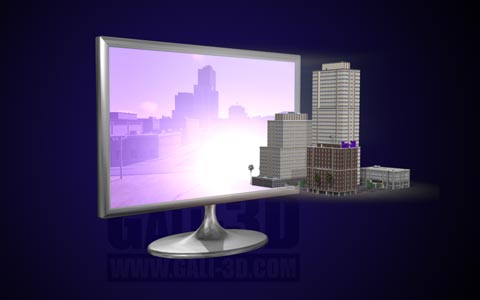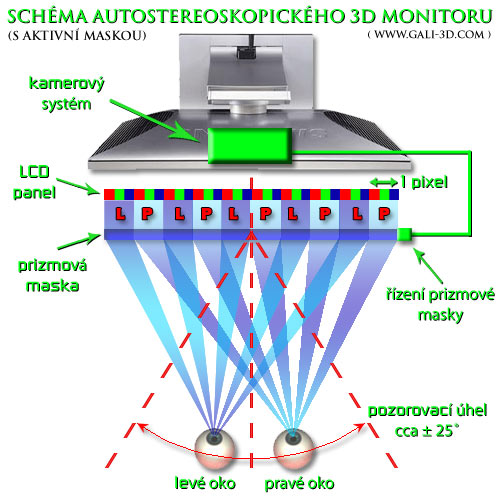3D Auto-Stereoscopic Monitors (3D without glasses)

3D Monitors without glasses - is it possible?
There was a strong believe - the glasses less auto stereoscopic monitors are the future. Unfortunately during the time it was demonstrated that this technology cannot deliver acceptable quality of the image. There is a strong believe 3D without glasses will use some other not yet know principle. Almost all of big display company had stopped the development of auto stereoscopic monitors.
3D without glasses
A mask placed in front of the visualization unit is a common element for most auto-stereoscopic monitors. This mask consists from optical elements or black strips. The target of this mask is to emit in given direction the image only form selected area of pixels. Observer in an optimal position can see in left a right eye different image. The position is different for each observer – it depends on the given person eye distance and the person distance form the monitor. The maximal resolution of the image is approximately one half of the monitor native resolution.
Auto-stereoscopic monitors with eye-tracking
For standard auto-stereoscopic monitor the proper position of the user is fixed. This is relay not comfortable. The solution can be extension of the monitor by eye-tracking. A camera track the user eye position and the monitor mask is moved to compensate for the user movement. Unfortunately the results of such system are not convincing. The system dos not work for multiple users and it have grate problems when used in dark areas.
Multi-view auto-stereoscopic monitors
Multi-view monitors are another solution for the small size of 3D viewing zone. The principle is based on a mask generating more than 2 viewing zones. It is even possible to se the scene from multiple perspectives form different zones. For such a monitor a 2 view stereoscopic movie is not sufficient and a monitor specific X view movie is required. In such case the native resolution of the monitor is downgraded by a factor of 5-9 times. Even the multi- view auto-stereoscopic monitor can't offer image quality comparable to glasses based solutions.
Advantages and disadvantages of auto-stereoscopic monitors
The main advantage is for sure no need of 3D glasses. But this is not balanced by the additional disadvantages, namely: low image resolution, good image only in viewing zone and problematic acquisition of multi-view movie data.
Overview of 3D stereoscopic technologies:
| technology | color informations | rozlišení obrazu | projection | monitors / tv | num. of viewers | 3D cinema expenses [price / operating costs] |
| Active 3D | full | high | yes (2) | yes (3) | limited (4) | high / high |
| Passive 3D | full | high | yes | yes | high | high / low (5) |
| 3D Polarization Modulator | full | high | yes | no | high | middle / low |
| 3D Auto-Stereoscopic Monitors | full (1) | low | no | yes | low | - |
| 3D Anaglyph | very bad | middle | yes | yes | high | low / low |
(2) - active 3D is not suitable for large 3D cinemas. Active 3D glasses are expensive and servising is also hard job (repairing, changing/recharging bateries).
(3) - active 3D displays (3D TV, computer 3D flat panels) provide the highest 3D quality from all 3D screens.
(4) - number of viewers is limited by expensive 3D glasses and the wireless signal range.
(5) - 3D Modulator is currently the best 3D technology for all modern 3D digital cinemas.

